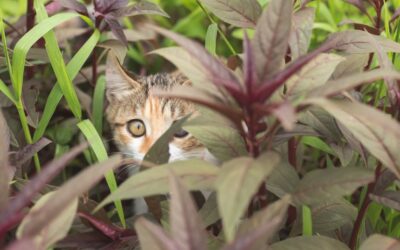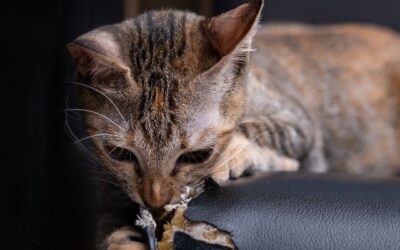Have you ever seen your domestic cat pounce on a toy with the same fierceness as a lion stalking its prey? Or perhaps you’ve noticed your cat kneading its paws on a soft surface, mimicking the behavior of wild cats in the wild. It’s no secret that domestic cats exhibit behaviors similar to their wild counterparts, but why is that the case?
Let’s first understand the difference between wild, domestic, and big cats.
Domestic Cats and their Wild Counterparts
As the name suggests, wild cats live in the wild and have not been domesticated. They are typically smaller than big cats and do not possess the same strength or ferocity. Examples of wild cats include bobcats, lynxes, and ocelots.
Domestic cats result from thousands of years of selective breeding and have adapted to living with humans. They are generally smaller than wild cats and have a more docile temperament. Domestic cats come in a wide variety of breeds, each with its unique characteristics and traits.
Big cats like lions, tigers, and leopards are much larger and more powerful than wild or domestic cats. They are also more ferocious and dangerous, as they have not been bred to live with humans. Big cats live in the wild and are apex predators, meaning they are at the top of the food chain in their respective ecosystems.
Domestic cats are descendants of wild cats. Specifically, domestic cats are believed to have descended from the African wildcat, first domesticated in ancient Egypt around 10,000 years ago. Despite this long period of domestication, cats have retained many of their wild instincts.
Let’s look at the fascinating world of feline behavior and see if we can uncover the reasons behind these similarities.
Physical Traits
One of the most apparent similarities between domestic and wild cats is their physical appearance. Wild cats tend to be larger than their domestic counterparts, but both types of cats have a similar bone structure and a powerful jaw. While wild cats tend to have more complex coat patterns, which help them blend in with their natural environment, domestic cats have a more uniform coat pattern. However, there are many different breeds with different coat colors and textures.
Claws
All cats have sharp and retractable claws, which they use for hunting and self-defence. These claws play an essential role in hunting, climbing, and self-defence. According to a study by researchers at Georgia Tech, a cat’s claws are designed to enter any sort of angle, and tear the prey apart.” The study also found that the claws have a unique curve that allows them to penetrate deeply into prey and hold on tightly.
Domestic cats also use their claws to climb trees and other structures, as well as to defend themselves from predators and other cats.

Whiskers
Whiskers are an important tool for both wild and domestic cats. These are highly sensitive and help them navigate their environment. Whiskers, also called Vibrissae, are specialized hairs connected to nerve cells. Cats use their whiskers to judge openings’ width and navigate through narrow spaces.
According to a study by researchers at Northwestern University, “A whisker is just a deformable beam interacting with springs.” Cats use their whiskers to detect changes in their environment, such as the movement of prey or obstacles in their path.
Ability to see in low light
Both wild and domestic cats can see better in low light. As they are primarily nocturnal hunters, their eyes are equipped with special cells that help them see in low light. A research study at the University of California shows that cats have a higher concentration of rod cells in their eyes than humans. Rod cells are specialized cells that help animals see in low-light conditions. Cats can see in the dark up to six times better than humans, but they don’t have night vision. They need some source of light to see.
Digestive system
One of the most exciting similarities between domestic and wild cats is their digestive system. Both types of cats are obligate carnivores, requiring a diet high in animal protein to thrive. This is because cats have a unique digestive system that is designed to break down and absorb nutrients from meat. Unlike herbivores or omnivores, cats cannot digest plant-based foods efficiently, so they require a diet high in animal protein to stay healthy.
Behavioral Traits
Along with physical traits, cats share fascinating behavioral traits with their wild relatives. Cats are known for their independent nature, which is true for wild, big, and domestic cats. They are solitary animals who prefer to hunt and explore on their own. Domestic cats may be more social than wild and big cats, but they still require plenty of alone time to rest and recharge.
Hunting
You may have noticed your cat stalking and pouncing on small objects. This happens as they have inherited their hunting instincts from their wild ancestors. Allowing cats to express their natural hunting behavior can positively impact their health and well-being. According to a study by researchers at the University of Bristol, cats allowed to hunt outdoors are less likely to be overweight or suffer from behavior problems than indoor-only cats.
Communication
Both types of cats also have a unique vocalization system. Domestic cats meow to communicate with humans, while wild cats have a more complex system of growls, hisses, and purrs to communicate with other cats. However, both types of cats use their vocalizations to express various emotions, including fear, anger, and contentment. It’s believed that most feline family members have a sense of smell up to 14 times stronger than humans.
While domestic cats may not have the same complex social structures as big cats, they communicate through vocalizations, body language, and scent marking. Positive social interaction with their human parents is essential for domestic cats’ psychological well-being.
Grooming habits
They are also known for their meticulous grooming habits, which they have inherited from their wild ancestors. Wild and big cats groom themselves to keep their fur clean and remove any scent that might attract predators. Domestic cats groom themselves for the same reason: to keep their coat in good condition.
Training and Learning
As we all know, cats respond well to training, such as responding to a call, hand gestures, sleeping, and other entertaining things, but what about wild cats? They, too, can be trained for simple tasks such as using a litter box or coming when called. Studies have shown that cats that are trained using positive reinforcement techniques, such as food rewards, are more likely to exhibit positive behaviors and less likely to exhibit negative behaviors. On that note, we’d love to share some interesting insights on training cats to sleep and let you sleep.
Agility and Athleticism
Domestic cats are known for their agility and athleticism, inherited from their wild and big cat ancestors. They can jump up to six times their body length in a single bound, run at high speeds, and easily climb trees.
Cats’ agility and athleticism are due to their physical traits, such as their flexible spines, powerful muscles, and innate hunting instincts. They can also run at high speeds and climb trees with ease. Training can allow domestic cats to climb and explore their environment, like cat trees and outdoor enclosures.

Solitary nature
Domestic cats and wild cats are solitary. While domestic cats can be social with humans and other cats, they are generally solitary hunters in the wild. This means they are used to being on their own and don’t require as much social interaction as other domesticated animals. This can make them seem aloof or independent, but it’s a part of their natural behavior.
Did you know?
Some breeds of domestic cats retain more of their wild traits than others. For example, the Bengal cat breed was created by breeding an Asian leopard cat with a domestic cat. As a result, Bengal cats have more wild instincts than other domestic cats and are known for being active and energetic.
The overall similarities between domestic cats and wild cats are fascinating to explore. They share many physical and behavioral traits that have helped them thrive in domestic and wild environments.
It’s important to understand these traits and provide the best possible care to our feline companions through several fun opportunities for exercise, play, socialization, and training. Remember that despite their similarities, each cat (big, wild, or domestic) is different, and we must appreciate their strengths and uniqueness!





0 Comments